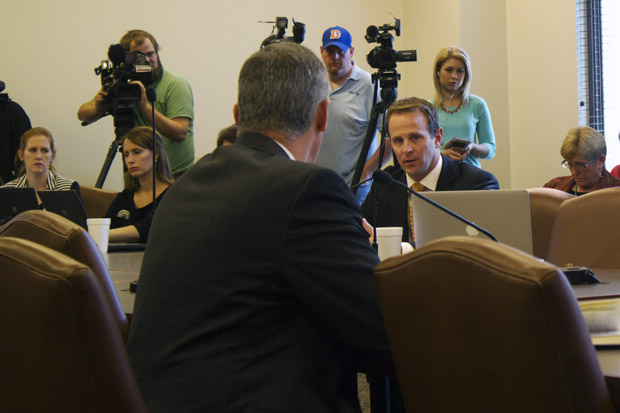Hearing on Disposal Well Rules Exposes Gaps in State’s Earthquake Response
-
Joe Wertz

Joe Wertz / StateImpact Oklahoma
Rep. Cory Williams, D-Stillwater, questions Secretary of Energy and Environment Michael Teague at an interim study and hearing about earthquakes and disposal well oversight held in October 2014.
Oklahoma’s earthquake surge is unrelenting. The shaking is rattling residents and cracking the foundations of homes.
The quakes have also strained state agencies, which are struggling to keep up with the ongoing swarm while simultaneously developing a longer-term plan to analyze and address factors that might be triggering the earthquakes.
‘Meaningful Action’
More than 400 magnitude-3.0 or greater earthquakes have shaken Oklahoma this year — four times as many as last year, and a new state record.
As the earthquakes continue, scrutiny from lawmakers and regulators is mounting.
State lawmakers on Oct. 28 questioned regulators, academics and anti-fracking activists at a Capitol hearing and interim study examining Oklahoma’s surge of earthquakes and its oversight of disposal wells, which scientists have linked to the quakes.
“We want answers and we’re hoping to see meaningful action and legislation to come out of this hearing,” said Angela Spotts of Stop Fracking Payne County. “We also want our elected officials to know you have the political backing. This is not a handful of people.”
The bipartisan study was requested by Jason Murphey, R-Guthrie, and Cory Williams, D-Stillwater, whose districts include some of the most quake-prone regions of the state.
“This is the No. 1 phone call that I get above all else,” Williams said. “Are you guys doing anything to monitor the seismic activity and provide for public safety?'”
‘Clearly’ Some Connection
The first scientific studies that linked Oklahoma’s earthquake surge to disposal wells used by the oil and gas industry were met with sharp skepticism from many state officials and the energy industry.
There’s still disagreement about the scope and scale of the connection, but today there’s general consensus that the wells energy companies pump full of waste fluid from drilling and fracking are responsible for at least some of the earthquakes.
“Clearly we are seeing earthquakes being triggered by saltwater disposal in some areas,” state seismologist Austin Holland of the Oklahoma Geological Survey said at the House hearing.
Officials at the Geological Survey and the Oklahoma Corporation Commission, the state’s oil and gas regulator, have been collecting, analyzing and sharing earthquake and well data to find trends and, if possible, help create a plan to inform future rules or practices that reduce the risk factors fueling disposal well earthquakes.
Data and Directives
Stricter rules for some disposal well operators went into effect in September 2014, and the Corporation Commission’s Oil and Gas Conservation Division is using red tape and inspections to increase the scrutiny of disposal well permits in earthquake-prone areas.
The commission also uses an internal “traffic light” system that matches worsening quake conditions with increasing directives for more detailed records and — if waste fluid disposal is thought to be triggering quakes — directives to operators to stop injection or requests to plug the well.
“We are screening every application that comes in to see if they’re in any of these areas that have been considered stressed areas,” Tim Baker, the Commission’s Pollution Abatement Manager, said at the hearing.
When a 4.0-magnitude or larger quake is reported, for example, commission staffers ask nearby disposal well operators to send in detailed reports of fluid volume and pressure. Regulators collect those numbers and send them to the Geological Survey, which, in turn, analyze the numbers and return a recommendation to the commission.
Holland told Rep. Murphey that the data-collection process is smothered by the sheer number of earthquakes. Weeks after a pair of 4.3-magnitude quakes struck near Cushing on Oct. 7 and Oct. 10, the Geological Survey still hasn’t received updated disposal well information from the Corporation Commission, Holland said.
When asked about the typical turnaround time for disposal well data to move from the operator, through the Corporation Commission, and to researchers at the survey, Holland said, “We’ve seen as quick as one or two days, and sometimes it’s been a few weeks or a month.”
Water Worries, Quake Concerns
The energy industry and disposal well operators are cooperating fully with commission requests, but Baker said data-sharing effort is complicated by the lack of a unified format or system for operators to turn in requested data. Secretary of Energy and Environment Michael Teague, who is leading the Gov. Mary Fallin-appointed Coordinating Council on Seismic Activity, has pledged to help correct that problem.
“Even though our data may be a few days in getting to the Geological Survey, that doesn’t mean we’re not doing anything,” Baker said.
After the quakes near Cushing, the Corporation Commission directed an operator to shut down a disposal well. Inspectors say the operator had drilled the well into basement rock, which is not allowed in Oklahoma and is a known risk factor for earthquakes. Baker told Williams, the other co-host of the hearing, that the state doesn’t fine operators for drilling into basement rock.
“There is no law that prevent you from inducing seismicity,” Baker said, because Oklahoma’s disposal well rules — and all rules in other states overseeing underground fluid injection — were written to protect drinking water, not to prevent earthquakes.
But that could change. The number of earthquakes in Oklahoma has increased exponentially, but so, too, has the number of high-profile hearings and meetings addressing the phenomenon.
Lawmakers haven’t drafted legislation addressing earthquakes, and no new oil and gas regulations are currently being considered. The 2015 legislative session starts in February, and the Corporation Commission is about to start its rule-making process.
The increased political and regulatory scrutiny could signal discussions about potential quake- or disposal well-related legislation or rules.
“Provide proposals and suggestions to us,” Corporation Commissioner Dana Murphy said to lawmakers and activists at the hearing. “We’re open to that.”
